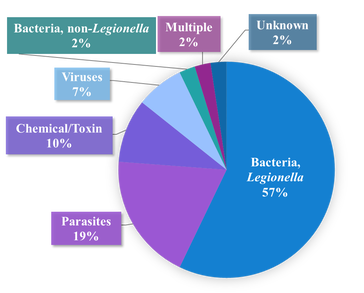|
Quick Facts
|
Image Credit: PWGC
|
About Legionella
Legionellosis is a respiratory disease caused by Legionella bacterium. The infection presents in two forms: Pontiac fever is a mild to moderate flu-like illness, which can advance to the more severe Legionnaires’ disease, a form of pneumonia.
Legionella was first discovered in 1976 when a mysterious illness struck staff and attendees at a convention for the American Legion in Philadelphia, PA. During this outbreak, 182 people were sickened and 29 died. Additional illnesses were eventually linked to cooling towers, water misters, decorative fountains, hot tubs, and showers. From these sources, the bacteria could be aerosolized and spread in micro-droplets of water that were inhaled by unsuspecting victims. Most cases today occur in middle-aged men and show a seasonal increase in summer to fall months, particularly in the eastern US, but women and older populations are also at risk; outbreaks do occur year-round.
Legionellosis is a respiratory disease caused by Legionella bacterium. The infection presents in two forms: Pontiac fever is a mild to moderate flu-like illness, which can advance to the more severe Legionnaires’ disease, a form of pneumonia.
Legionella was first discovered in 1976 when a mysterious illness struck staff and attendees at a convention for the American Legion in Philadelphia, PA. During this outbreak, 182 people were sickened and 29 died. Additional illnesses were eventually linked to cooling towers, water misters, decorative fountains, hot tubs, and showers. From these sources, the bacteria could be aerosolized and spread in micro-droplets of water that were inhaled by unsuspecting victims. Most cases today occur in middle-aged men and show a seasonal increase in summer to fall months, particularly in the eastern US, but women and older populations are also at risk; outbreaks do occur year-round.
|
Legionella Outbreaks
|
Full infographic available:
| ||||||
|
Who is most at risk?
|
Treatment While many outbreaks are associated with larger buildings and healthcare facilities, cases associated with smaller businesses and homes are likely to go undetected. Point-of-use (POU) treatment techniques such as Ultraviolet (UV) disinfection and filters rated for removal of bacteria are effective barriers and recommended to minimize at-risk population exposures to Legionella from faucets and showerheads. |
Related Articles
- 04/2013 Evidence of Drug-Resistant Bacteria in Water [Link]
- 12/2013 Deadly Legionella: Commonly Found in US Water Systems [Link]
- 06/2015 POU Prevention of Healthcare-acquired Waterborne Infections [Link]
- 07/2016 The Rise of Legionella [Link]
- 01/2017 POU Filtration: A Water Safety Plan Essential [Link]
- 07/2017 Effective Immediately: Healthcare Facilities Required to Reduce Legionellosis Risks from Tap Water [Link]






